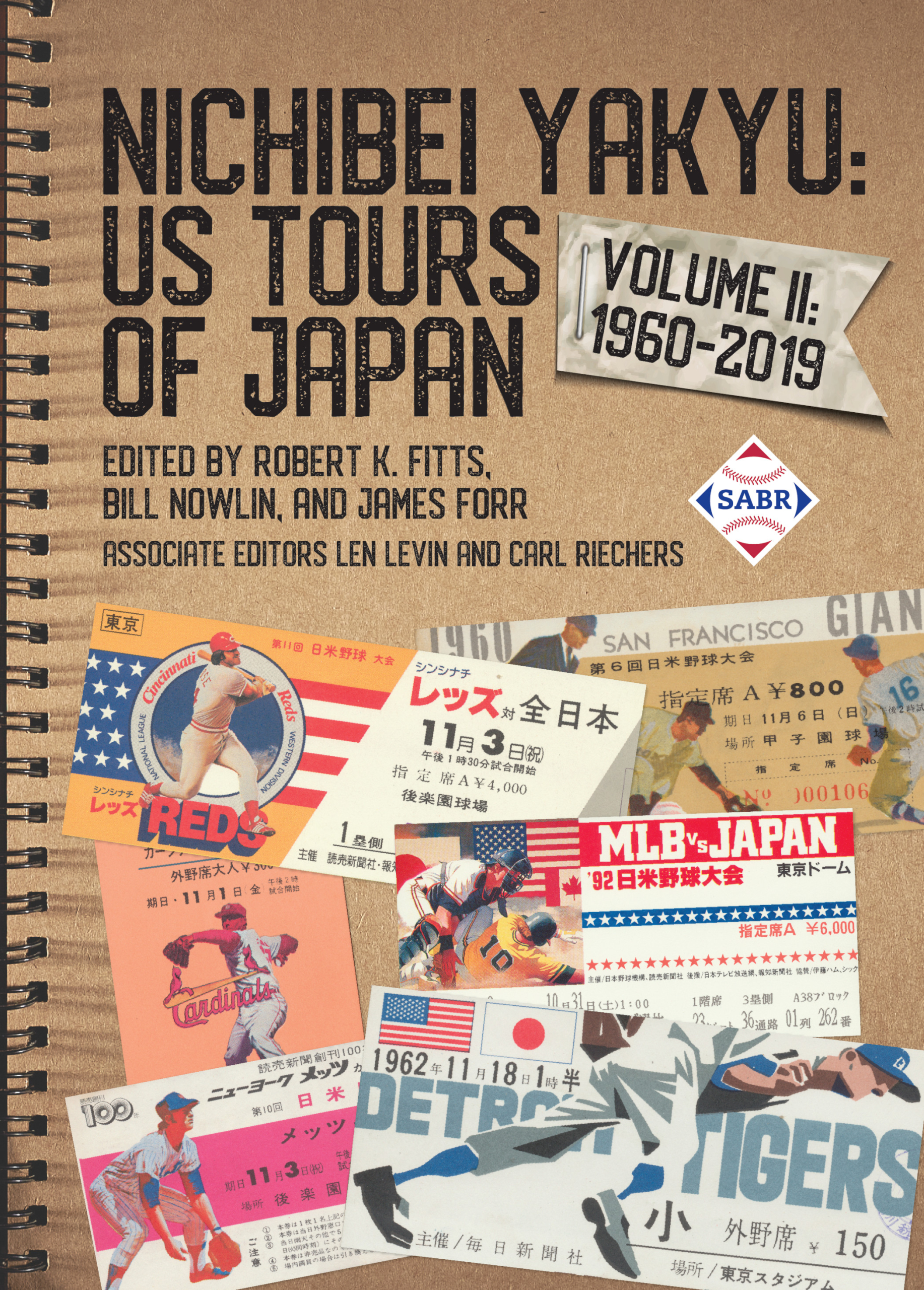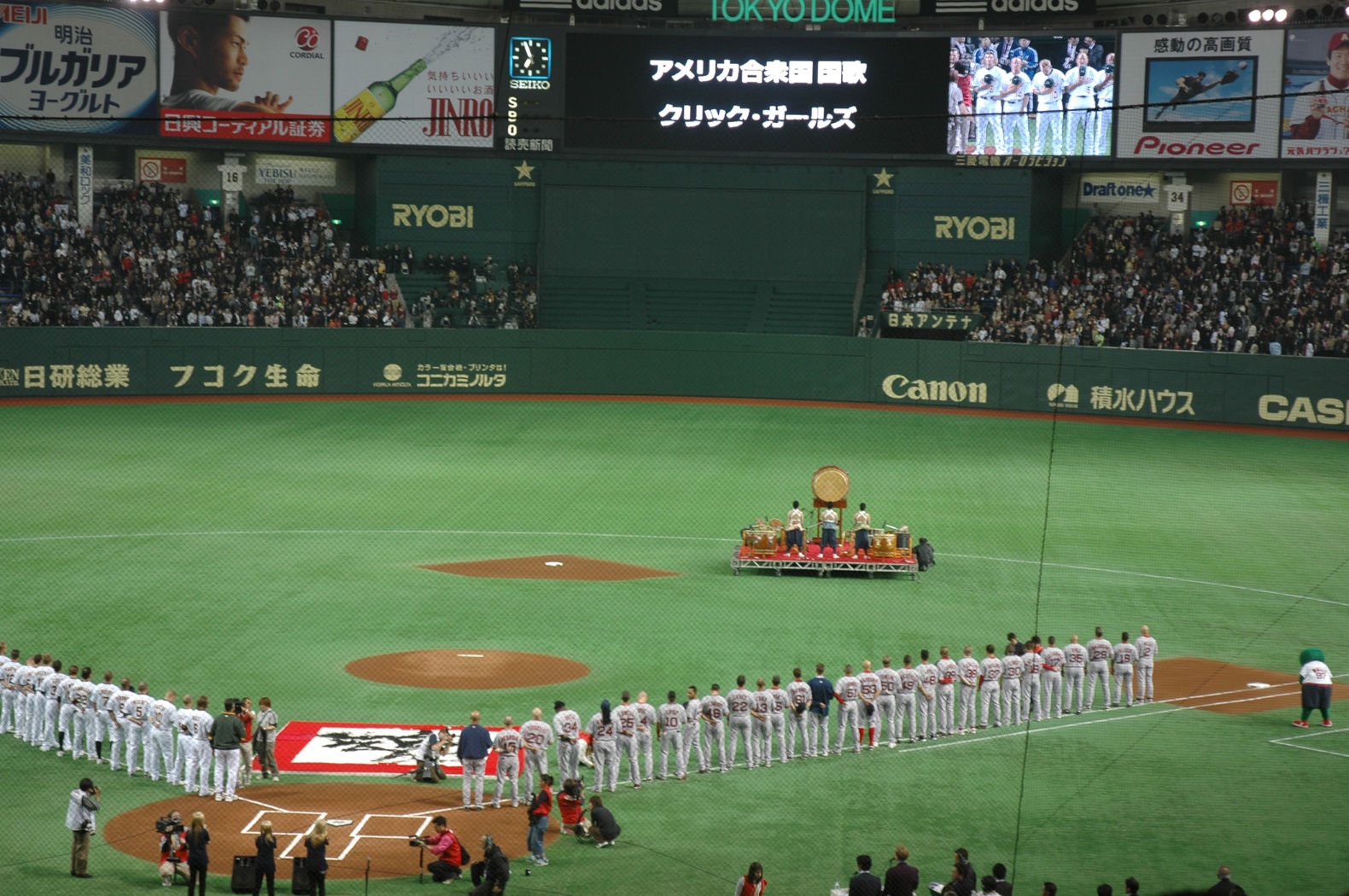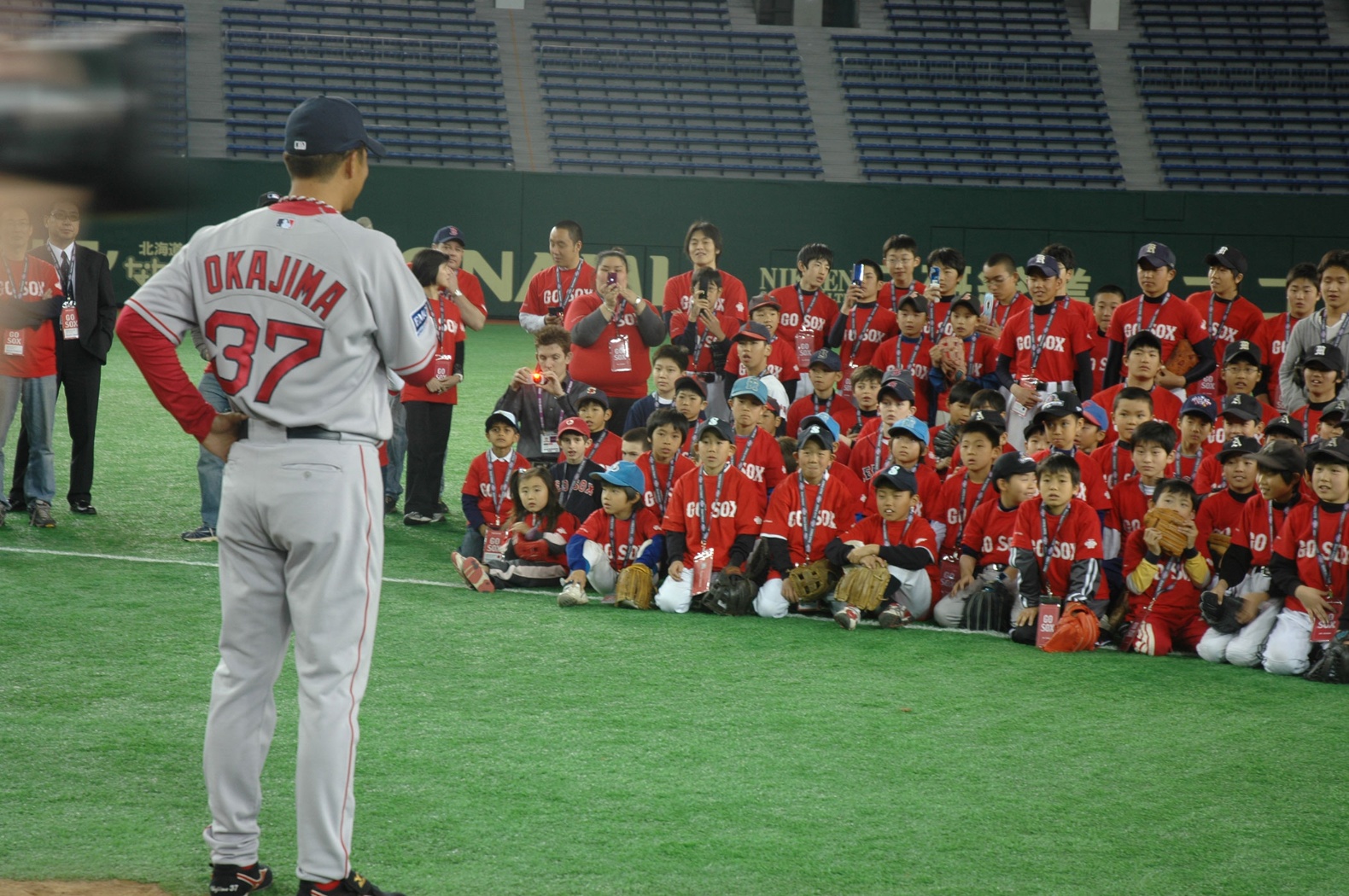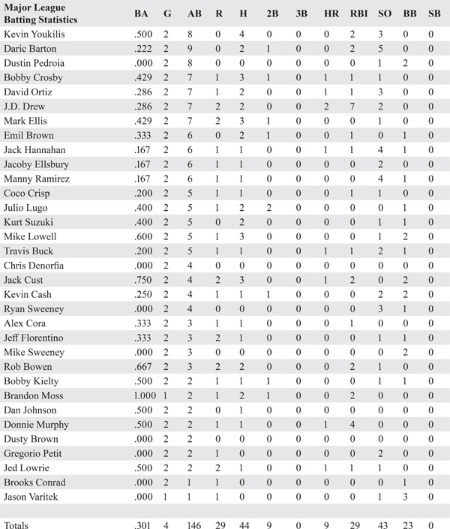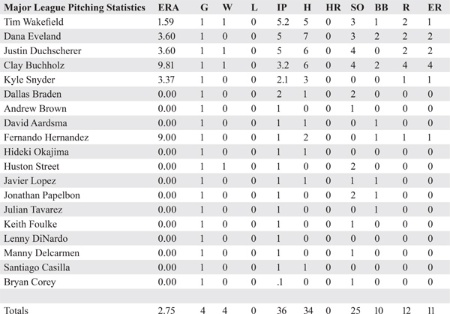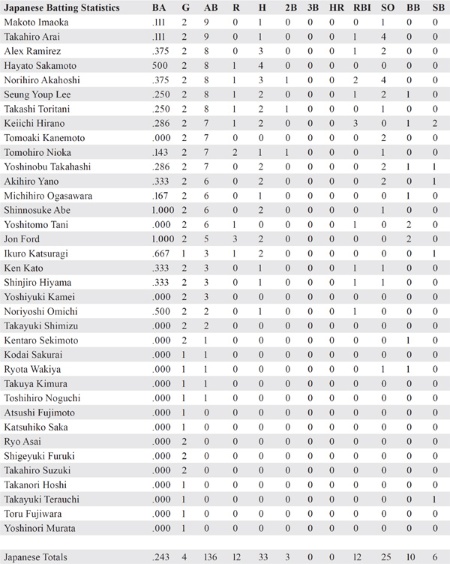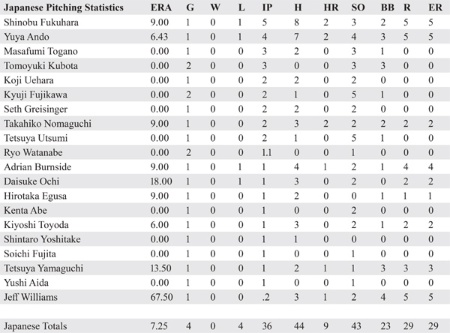2008 Opening Series in Japan: Boston Red Sox vs. Oakland Athletics
This article was written by Bill Nowlin
This article was published in Nichibei Yakyu: US Tours of Japan, 1960-2019
Opening Day ceremonies at the Tokyo Dome on March 25, 2008. (Courtesy of Bill Nowlin)
The third in a series of five Major League Baseball visits to Japan opening the regular season featured the Boston Red Sox and Oakland Athletics in March 2008. Earlier series had been in 2000 with the New York Mets and Chicago Cubs playing each other and both teams facing off against the Seibu Lions and Yomiuri Giants, and in 2004 with the New York Yankees and Tampa Bay Devil Rays visiting Japan and playing the Hanshin Tigers and Yomiuri Giants. Both the later visits, in 2012 and 2019, featured the same visiting teams from the West Coast of the United States – the Oakland Athletics and the Seattle Mariners.
Preparing for the Opening Series
The 2008 visit was the first to Japan for both Oakland and Boston.1 The two scheduled games in Tokyo were deemed home games for Oakland. Oakland had finished the 2007 season with a record of 76-86, in third place in the American League West Division. The Red Sox had won the AL East, swept the Division Series, battled Cleveland to a seventh-game win in the ALCS, and then swept the Colorado Rockies in the World Series. Oakland owner Lew Wolff joked, “It’s very hard to get a ticket to the Boston games, so that’s one of the reasons we came out.”2
The A’s had spring training in the Cactus League, and flew out of Phoenix, a 12-hour flight.3 A’s equipment manager Steve Vucinich said, “I heard they don’t have sunflower seeds there, so we’re bringing our own.”4 The Red Sox had a 19-hour flight from Florida via Chicago on a chartered Japan Air Lines 747.
In order not to disadvantage the visiting teams, as they prepared for the bulk of the championship season while wedging in the trans-Pacific visit, both teams scheduled three more spring-training games after the Japan Opening Series and before resuming the regular season.
The trip was nearly called off at the last minute. Not long before they were due to make the flight to Japan, Red Sox players raised an issue that had come to their attention. Represented by the Players Association in negotiations with Major League Baseball, the players had been promised a $40,000 per person incentive for the trip, but not all of the coaches had been. The Red Sox players voted to boycott the trip and not board the plane unless the coaches were paid the same. The Oakland players heard of this and held their own meetings, but their discussions never came to a vote because matters were worked out. MLB came up with $20,000 per coach, and Red Sox owners matched that for the Red Sox coaches. Other team personnel in the traveling party were promised additional pay as well.5
For Red Sox shortstop Julio Lugo, it was his second trip to Japan. He had been with Tampa Bay on the 2004 tour, playing the Yankees. He said it was far more difficult to adjust after returning home than on arriving in Japan. “It took me a month and a half to get readjusted,” Lugo said. “I felt it when I was playing. I played good during that period of time, but I felt it a lot. I couldn’t fall asleep, and my appetite wasn’t good. You adjust for a week (in Japan), and then you’ve got to turn around.”6
A’s second baseman Mark Ellis wasn’t sure which would be more difficult, but he wasn’t as worried as Lugo about feeling fatigue once back in the States. After arriving in Japan, he said, “I’ve heard both. I’ve heard it’s harder going (to Japan), and that it’s harder coming back. It’ll be fine. We have four or five days before we play Boston. We’ll be all right. I got less sleep than I thought I was going to, but I feel pretty good.”7
As the Games Got Underway
There was some extra excitement in Japan for the games, and not only because the Red Sox were the reigning World Series champions but also because two members of the team were returning to play in their native land – starting pitcher Daisuke Matsuzaka and reliever Hideki Okajima. Matsuzaka had starred in Japan since high-school days and had played eight seasons, through 2006, with the Seibu Lions. Okajima had played parts of 11 seasons for the Yomiuri Giants, from 1995 through 2005. He had joined the Red Sox and become the first Japanese-born pitcher to appear in a World Series game, throwing 2⅓ perfect innings in Game Two of the 2007 World Series against the Colorado Rockies. With a win in Game Three, Matsuzaka was the first Japanese native to win a World Series game.
The A’s received some attention with Kurt Suzuki, a Hawaiian native but with Japanese ancestry. His grandparents were from Nagoya, and he even spoke a little Japanese.8
Prior to the Opening Series, both major-league clubs warmed up by playing a game each against the Yomiuri Giants and the Hanshin Tigers. The umpires for these exhibition games were two from MLB and two from NPB.
There were differences that visiting Americans noticed immediately, before the games at the Tokyo Dome, home ballpark for the Yomiuri Giants. When Japanese batters took batting practice, they did so from two adjacent cages, permitting them to get in twice as much practice in the same period of time, though those in the field had to keep a sharper eye.
Because slightly different baseballs were used by Nippon Professional Baseball and Major League Baseball, it was decided – so as not to disadvantage either team – that each team could use the baseball with which they were familiar when they were in the field. The Japanese baseball was slightly smaller, and its surface was a little “tackier” – the Japanese pitchers thus could get their accustomed grip on the ball, and the fielders would likewise find handling the ball familiar.
Announcements before and during the game were in both Japanese and English. Radar-gun readings were in kilometers per hour, not miles per hour. Red Sox reliever Jonathan Papelbon’s fastball hit 151.
And then there were the fans. Particularly for the four games involving the Japanese ballclubs, the ways fans showed their support for their team were very different. Team supporters sat in their own team’s “cheering section” where an organized band (with drums and trumpets) would perform while orchestrated by leaders (perhaps wearing white gloves and standing on a small platform) who would use whistles and hand motions to get fans to cheer and sing songs from distributed lyric sheets. Noisemakers and megaphones helped amplify the synchronized rooting.9
Music between innings ranged from the Beach Boys to American country music to hip-hop to a Japanese version of “YMCA.”10
Returning to Japan as a member of the Boston Red Sox, Hideki Okajima addresses young Japanese players (Courtesy of Bill Nowlin)
The Games in Tokyo
The first two exhibition games were both one-run games. The next day, both American teams perhaps had settled in a bit better and won with ease, by very similar one-sided scores of 10-2 and 9-2.
March 22, 2008
Boston Red Sox 6, Hanshin Tigers 5
At Tokyo Dome
Starters for the first of the two exhibition games involving Boston were Yuya Ando for the Tigers and Clay Buchholz for the Red Sox. Batting in the top of the first, Boston jumped on Ando for four runs, the first run on a solo home run over the left-field wall by DH David Ortiz followed by a three-run homer to left-center field by right fielder J.D. Drew. The Red Sox added a fifth run in the second inning, on a Kevin Youkilis single, but the Tigers got to Buchholz for four runs in the bottom of the second.
The Ortiz home run was his second in Japan. He had hit one in November 2004, playing with a team of all-stars, that one hitting the Tokyo Dome lights in right field, and measured at 514 feet. “It was [after] the end of the season,” Ortiz said, regarding the 2004 home run. “I’m glad to hit one to start the season.”11 Each team scored one more run in the sixth inning. Youkilis drove in his second run of the game, while Keiichi Hirano’s sacrifice fly gave the Tigers their fifth run. That made it 6-5.
Leadoff batter and center fielder Norihiro Akahoshi had two hits – one a double—and drove in two runs. The other three Tigers runs were all driven in the by the number-two batter, second baseman-right fielder Keiichi Hirano. Another Tiger hit a double – shortstop Takashi Toritani, who had two RBIs. The DH, Ikuro Katsuragi, had two base hits.
Three other Red Sox pitchers – Javier Lopez, Manny Delcarmen, and Jonathan Papelbon – threw scoreless innings in the seventh, eighth, and ninth.
In all, Hanshin had 10 hits to Boston’s nine. Each team committed one error. Boston pitchers struck out eight and walked four; Tigers pitchers struck out nine but walked six.
Ando worked four full innings. Ryo Watanabe pitched a scoreless fifth. Hirotaka Egusa was charged with giving up Boston’s sixth run, but the loss was assigned to Ando. Tomoyuki Kubota pitched the seventh and eighth innings and Kyuji Fujikawa worked the ninth, striking out two. “The MLB strike zone is slightly different from ours,” Hanshin pitcher Yuya Ando said after facing the Red Sox. “This was a good experience for me today.”12
Japan Times sportswriter Jason Coskrey wrote, “The Tigers went blow-for-blow with the World Series champions, twice cutting the lead to one run, after falling behind 5-0 early, but could never bring the tying run around to score. Hanshin ended an inning with runners in scoring position on four different occasions.”13
“There weren’t any home runs,” Tigers manager Akinobu Okada said of his team. “But we were able to pretty much execute what Hanshin is good at by using speed and fielding. Overall, I think it was not a bad game today.”14
March 22, 2008
Oakland Athletics 4, Yomiuri Giants 3
At Tokyo Dome
With so much attention focused on the reigning World Series champion Boston Red Sox, coverage even in the Japan Times was light for the exhibition games played by the Oakland Athletics. The first Tokyo game, featuring the hometown Yomiuri Giants, still drew 26,434 and they were rewarded by a one-run game decided in the ninth inning. Dana Eveland took the mound for the A’s and future Red Sox pitcher Koji Uehara started for Yomiuri.
Catcher Ken Kato singled in a run to give the Giants an early 1-0 lead in the bottom of the second inning. They added a second run in the third inning, again on a single, this time by Alex Ramirez, who had played 135 major-league games for Cleveland and Pittsburgh from 1998 to 2000, but then spent the next seven seasons playing for the Yakult Swallows. This was the first year of four that he played for the Giants.15
In the fourth inning, Oakland tied it up on back-to-back solo home runs by Bobby Crosby and Jack Hannahan. Eveland said he was tiring by the third inning, which came less than 48 hours after the A’s landed, but continued through the fifth when he was relieved by Santiago Casilla.16 The score remained 2-2 through eight. In the top of the ninth, the Athletics’ Rob Bowen hit a two-out double, with a run scoring on an error by the Giants on the play. Oakland added one more run on Emil Brown’s single up the middle, which drove in Bowen.
The 4-2 lead was trimmed in the bottom of the ninth when Noriyoshi Omichi pinch-hit and singled to drive in a run, making it 4-3, but Seung Yuop Lee hit a fly ball for the final out of the game.17
Oakland first baseman Dan Johnson was impressed by one thing about the Japanese fans: “They’re very respectful. There’s no booing. When their players do something bad, they’re not getting on them. All they do is stay positive and cheer.”18
The Athletics players weren’t about to miss the opportunity to have a little fun. After the Giants game, when he went to his locker to dress, all of Johnson’s street clothes were gone. The only thing in the locker for him to wear was a “pink kimono with a flower pattern.”19
March 23, 2008
Oakland Athletics 10, Hanshin Tigers 2
At Tokyo Dome
The second game the A’s played was a lopsided one, a 10-2 win over the Hanshin Tigers. “It’s good to get the offense moving,” said manager Bob Geren after the game. “We swung the bat pretty good. I’m looking forward to the season opening.”20
The day game drew 16,746 but was dwarfed by the 44,558 who turned out to see the Red Sox play the Yomiuri Giants that evening.
The Athletics kicked off the scoring with two runs in the top of the first inning when the Tigers’ right-handed starting pitcher, Shinobu Fukuhara, surrendered a two-run homer to Jack Cust. But Hanshin got one back off A’s starter Justin Duchscherer in the bottom half of the inning. Travis Buck led off the third inning with a solo home run. The A’s scored two more on a double by Daric Barton.
The Tigers added a second run in the bottom of the fifth as they “responded to the ever-enthusiastic Tora fans that filled the left-field bleachers by rapping out four straight hits” and scored one on Shinjiro Hiyama’s RBI single.
Oakland struck back in the top of the sixth, adding four more runs on a grand slam that pinch-hitter Donnie Murphy banged off Tigers reliever Jeff Williams. Duchscherer was the winning pitcher.
March 23, 2008
Boston Red Sox 9, Yomiuri Giants 2
At Tokyo Dome
Tim Wakefield was the starter for the Red Sox, giving up two runs in 5⅔ innings. He departed only because manager Terry Francona wanted his relievers to get in some work, too.
The Giants took a quick 1-0 lead in the bottom of the first when Tomohiro Nioka was hit by a pitch. He later scored on Seung Yeop Lee’s bloop single. In the third inning, Lee got on base again, and scored on a groundball by Yoshitomo Tani.
Giants starter Seth Greisinger worked the first two scoreless innings.21 In the third inning, Tetsuya Utsumi relieved Greisinger. In the top of the sixth, J.D. Drew came to the plate with the bases loaded and one out.22 On the mound was Giants left-hander Adrian Burnside, an Australian.23 Drew had homered the night before. He hit another one, a grand slam, giving the Red Sox a 4-2 lead.24
There was additional scoring in the game, all by Boston. Jed Lowrie hit a solo homer in the eighth. Later in the eighth, Brandon Moss had a two-run single. In the ninth inning, the eighth and ninth Red Sox runs came on hits by Coco Crisp and Alex Cora.
There was another star in the game, too, one with a strong local appeal – former Giants pitcher Hideki Okajima. The Giants manager was Tatsunori Hara, a former teammate and manager of Okajima’s with the Giants. Hara noted, “Okajima both started and closed for the Giants, and was one of the more popular players for Giants fans, including myself. Tonight’s applause may have been the biggest he’s received here.”25
Okajima was brought into the game to pitch an inning of relief. He was welcomed with a “rousing ovation” from the Giants fans in the Tokyo Dome, and hundreds of flashbulbs went off during every one of his pitches in the scoreless seventh inning. Through a translator, he did say he had made a request of his manager. “I told Tito that I wanted to pitch today, because I wanted to face some old teammates. I was nervous,” he said. “I wasn’t bothered by the flashes, but I was nervous when I was warming up.”26
Because of the different baseballs used in MLB, Okajima – whose best pitch had been a curveball with the Giants – developed a changeup with Boston. “Okajima said in an interview … [that] he had trouble throwing the curve with the Sox because of the seam on the balls. … His finger would slip and the ball wouldn’t go where he wanted in the major leagues.” He said: “Different pitcher. Mentally I’m different. I am enjoying major-league baseball. [I’m] a totally different pitcher now.”27
After the game, Daisuke Matsuzaka – less than 48 hours before pitching the first regular-season game of the 2008 season against the Oakland Athletics, said, “It was nice to hear the Japanese way of cheering after a long time. I am happy to return to Japan as a member of the world champion team.”28
March 25, 2008
Boston Red Sox 6, Oakland Athletics 5 (10 innings)
At Tokyo Dome
Opening Day for the two US teams was on March 25, also at “the Big Egg” – the Tokyo Dome. The 7:10 P.M. game drew 44,628.29 Former Prime Minister Yoshiro Mori threw out the first pitch, bouncing it once in front of the plate.
Joe Blanton was Oakland manager Bob Geren’s choice to start. Red Sox second baseman Dustin Pedroia (the 2007 AL Rookie of the Year) hit Blanton’s second pitch for an infield single that glanced off the shortstop’s glove, but he was the only Boston batter to reach base in the first inning.
Daisuke Matsuzaka started for the Red Sox. “Dice-K,” as he was familiarly called in New England, had been signed by the Red Sox in December 2006, after eight years with the Seibu Lions of Nippon Professional Baseball. His record with the Lions had been 108-60 with a 2.95 ERA. He had led the Pacific League four times in strikeouts, three times in wins, and twice in ERA. On November 11, 2004, he had thrown a 5-1 complete-game five-hitter and beaten a team of major-league baseball all-stars at the Sapporo Dome. He was 3-0 for Japan during the 2006 World Baseball Classic and was the MVP of the tournament. For the Red Sox in 2007, his 201 strikeouts set a franchise rookie record. He won 15 games during the regular season and won Game Three of the 2007 World Series against the Colorado Rockies.30
The second batter Matsuzaka faced in this game – second baseman Mark Ellis – homered over the fence in left-center. Then a walk and a hit batsman put runners on first and second. They both moved up on a wild pitch. Another walk loaded the bases. Shortstop Bobby Crosby hit a ball that Matsuzaka fielded on the third-base side, throwing to first base for the second out as the runner scored from third. 2-0, Oakland. Matsuzaka got out of the inning, striking out third baseman Jack Hannahan. Even though fans had been asked not to use flash cameras, thousands of flashbulbs went off when Matsuzaka pitched.31
The Red Sox took a 3-2 lead in the sixth as Pedroia led off with a catchable ball off the right-field wall that went for a double. First baseman Kevin Youkilis drew a walk. David Ortiz popped up foul along the left-field seats. Manny Ramirez grounded right down the third-base line and into left field past a diving Hannahan for a double that scored Pedroia from second and Youkilis from first base. Mike Lowell struck out, but Brandon Moss singled between first and second and drove in Ramirez.32
In the bottom of the sixth, Boston switched pitchers, with Kyle Snyder replacing Matsuzaka. Crosby singled up the middle. Hannahan homered to right field. The A’s had taken a 4-3 lead. Snyder retired the next three.
Huston Street came in to work the ninth, hoping to hold the 4-3 lead. After Lowell flied out to center, Moss hit a home run just inside the foul pole in right field, tying the game.33 It was his first major-league home run.34 Jason Varitek struck out and Jacoby Ellsbury lined out.
Hideki Okajima took over for Boston. He had relieved in 66 Red Sox games in 2007, leading all American League rookies in games pitched and setting a franchise rookie record. He had a 2.22 ERA; his 27 holds were the most by any Red Sox pitcher since the statistic was first compiled in 1987. His eight appearances in the postseason were tops on the team. By working 2⅓ scoreless innings in Game Two of the 2007 World Series, he became the first native of Japan to pitch in a World Series game. In this game, after striking out leadoff batter Kurt Suzuki, Okajima walked Mike Sweeney on four pitches, but he retired the other Athletics without any difficulty.
In the top of the 10th, Boston shortstop Julio Lugo beat out a hard-hit single on the line to deep third base. Pedroia bunted, a sacrifice that put Lugo on second base. Youkilis struck out. With the open base, Ortiz was walked intentionally. But Manny Ramirez doubled off the right-field wall and drove in both runners.35 Street was relieved by Lenny DiNardo, who got the next batter out.36 On asking Street to walk Ortiz and then face Ramirez, Geren more or less shrugged, “They’re both great hitters and you have to pick one or the other.”37 Ramirez was using unfamiliar Japanese-made SSK bats because his American-made Diablo bats were colored ones and had not been preapproved.38
Boston closer Jonathan Papelbon relieved Okajima. He walked first baseman Daric Barton, then struck out Cust. Left fielder Emil Brown doubled into the gap in right-center, driving in Barton, but Brown was out in a rundown trying to reach third base when Youkilis cut off the relay throw.39 The next two Athletics – Crosby and Hannahan – both singled, but due to his gaffe, Brown was no longer on base. Catcher Kurt Suzuki grounded out to first base, Papelbon covering, for the final out.40 Okajima got the win.
Manny Ramirez, with two two-run doubles – including the game-winner – was unsurprisingly named the MVP of the game, winning a check for 1 million yen (said to be about $10,000 US at the time) and a Ricoh color copier.41 It was Manny Ramirez’s third trip to Japan; he had visited before in 1998 and had been on the 2004 All-Star team that played in Japan that November but had left after three days due to what was reported as a sore left hamstring.42
Matsuzaka acknowledged, “I did feel a little nervous and a little excited and that might have shown.”43
March 26, 2008
Oakland Athletics 5, Boston Red Sox 1
At Tokyo Dome
The starting pitcher for Oakland in the second game was Rich Harden, starting his sixth season with the Athletics. The Red Sox starter was left-hander Jon Lester; he had gone 11-2 over the two previous years – and had won the Red Sox World Series clincher in 2007 – but 2008 was his first full season in the majors.
The Athletics took a 1-0 lead in the second when Lester gave up a double down the left-field line to shortstop Bobby Crosby. After striking out Hannahan, he walked catcher Suzuki and gave up center fielder Chris Denorfia’s single to center field. Oakland added three runs, taking a 4-0 lead in the bottom of the third. Mark Ellis walked. After one out, DH Mike Sweeney singled. Emil Brown came up. His poor baserunning cost the A’s in the first game, but this time up he hit a three-run homer over the left-field wall.44 His home run provided the runs that won the game.
After the first four innings. David Aardsma relieved Lester, who had struggled with his control and thrown 83 pitches.45
In the sixth, Manny Ramirez hit a two-out solo home run off Harden. The homer, into the left- field seats, was the only run the Red Sox got in the game.
Oakland manager Geren called on two former Red Sox relievers – both had been on the 2004 world championship team. Keith Foulke and Alan Embree were asked to work the eighth and ninth and hold Oakland’s 4-1 lead. Foulke got Pedroia to fly out to right field. Kevin Youkilis reached on an error by Crosby at short. David Ortiz hit a fly ball to deep right field, but it was caught for the second out. He was 0-for-7 in the two games in Japan. Ramirez struck out. In the bottom of the eighth, the A’s added a fifth run when Suzuki doubled to left-center field and scored on a single to center by Jeff Fiorentino.
The Red Sox were down, 5-1. Embree took over from Foulke in the ninth. Mike Lowell led off with his second hit of the game, another single to left field. Sean Casey pinch-hit for Brandon Moss and hit into a 4-6-3 double play. Embree struck out Jason Varitek for the final out. Oakland pitching had held Boston to five hits. Harden, who struck out nine in his six innings, got the win. Lester took the loss.
With the win, each of the visiting American teams had won a game in the two-game Opening Series.
Afterward
Not everyone liked the idea of these games being played overseas before what had been the traditional season opener in Cincinnati. Two columnists for the Atlanta Journal-Constitution decried the break from tradition, Furman Bisher in a column headlined “Sayonara, Baseball Tradition,” and Terence Moore, who wrote, “It’s all about the potential for the greedy folks involved with these leagues to add megabucks.”
BILL NOWLIN, always looking for an excuse to travel, has seen the Red Sox play in Japan, England, an exhibition game in the Dominican Republic, and even in Canada. For the visit to Tokyo, he sat in on a meeting of SABR’s Tokyo Chapter. A Boston native, he was born into Red Sox fandom; his father sold hot dogs at Fenway Park for a couple of years as a teenager. Now retired after 50 years with Rounder Records, Bill has written a bunch of books on Boston baseball and ballplayers, and helped edit a good number of books on other teams and other players.
Notes
1 Oakland, however, had planned to go to Tokyo in 2003 and play the Seattle Mariners, but one day before they were due to leave, the United States’ war in Iraq began, and the trip was scrubbed. See Susan Slusser, “Tokyo-Bound, Five Years Later,” San Francisco Chronicle, March 16, 2008: D1.
2 Amalie Benjamin, “Timlin’s Availability Will Be Up in the Air,” Boston Globe, March 22, 2008: E5.
3 Oakland fans at home needed to tune in at 3:10 A.M. Pacific time to watch the game on television. In Boston, the game started at 6:10 A.M. local time. With three hours difference in US time zones and a seven-hour-longer flight, how the differences might affect the two teams was of some concern.
4 Slusser, “Tokyo-Bound, Five Years Later.”
5 Associated Press, “Payments for Japan Trip Nearly Cause Boycotts,” Japan Times, March 21, 2008: 12. The story is detailed in Terry Francona and Dan Shaughnessy, Francona – The Red Sox Years (Boston: Houghton Mifflin, 2013), 205-207. See also Susan Slusser, “A’s Trip to Japan Nearly Called Off.” San Francisco Chronicle, March 20, 2008: D1.
6 Joe Stiglich, “A’s Love Trip to Tokyo, but Their Bodies May Not,” Oakland Tribune, March 27, 2008.
7 Stiglich, “A’s Love Trip to Tokyo, but Their Bodies May Not.”
8 Susan Slusser, “Suzuki’s Heritage Makes Him a Hit,” San Francisco Chronicle. March 22, 2008: D3. A’s hitting coach Ty Van Burkleo had played four seasons in Japan, for both Seibu and Hiroshima. See Susan Slusser, “Fans in Japan Up Late to Greet A’s,” San Francisco Chronicle, March 21, 2008: D1, D5. At a welcoming reception on Friday night, March 21, both Matsuzaka and Red Sox slugger David Ortiz donned protective eyewear and participated in the ceremonial breaking of a sake barrel. See Dan Shaughnessy, “So Far, So Good as Interesting Scenes Abound,” Boston Globe, March 24, 2008: D1.
9 See text and illustrations in “A Fan Experience in Japan,” Boston Globe, March 24, 2008: D6.
10 Joe Stiglich, “Oakland Players Love It in Japan,” March 24, 2008; EastBayTimes.com, https://www.eastbaytimes.com/2008/03/23/oakland-players-love-it-in-japan/.
11 “Ortiz, Drew Each Homer as Sox Win First Exhibition,” Hartford Courant, March 23, 2008: E11.
12 Jason Coskrey, “Japanese Ballplayers Relish Chance to Test Skills against MLB Competition,” McClatchy-Tribune Business News, March 23, 2008. https://www-proquest-com.mcpl.idm.oclc.org/docview/465721546/17CF4F9C17CC43B0PQ/35?accountid=69. Accessed June 3, 2021.
13 Jason Coskrey, “Ortiz, Youkilis Spark BoSox Past Pesky Tigers,” Japan Times, March 23, 2008: 24.
14 Coskrey, “Ortiz, Youkilis Spark BoSox Past Pesky Tigers.”
15 Alex Ramirez completed his career with the Yokohama Bay Stars in 2012 and 2013, finishing 13 seasons and 1,744 games in NPB with a .301 batting average, 380 home runs, and 1,272 runs batted in.
16 Stiglich. “A’s Love Trip to Tokyo, but Their Bodies May Not.”
17 Details of this game derive from Coskrey, “Ortiz, Youkilis Spark BoSox Past Pesky Tigers.”
18 Joe Stiglich, “There’s No Booing in Japanese Baseball?” EastBayTimes.com, March 24, 2008; https://www.eastbaytimes.com/2008/03/24/as-notes-theres-no-booing-in-japanese-baseball-2/.
19 Stiglich, “Oakland Players Love It in Japan.”
20 Jason Coskrey, “Drew’s Sixth-Inning Grand Slam Powers Red Sox Past Giants,” Japan Times, March 23, 2008: 20. As the headline of the article indicates, the focus of attention was more on the Red Sox. All quotations in this article come from Coskrey’s game account unless otherwise indicated.
21 Greisinger had broken in with the Detroit Tigers in 1998, starting 21 games. He missed many games, and two full seasons, due to injuries, ultimately playing in 42 major-league games, with a 10-16 record. He had two years of play in Korea and one in Japan under his belt coming into the 2008 season. He was 17-9 (3.06) in 31 starts with the Giants in 2008.
22 Drew had homered the night before, against the Hanshin Tigers. Before the game, the electronic scoreboard at the Tokyo Dome had – more than once – shown video of the first-inning grand slam he had hit in Game Six of the 2007 American League Championship Series. The Red Sox won that game, bearing Cleveland 12-2 and won Game Seven as well, on their way to sweeping the Rockies in the World Series.
23 Burnside had been in the LA Dodgers system starting in 1996 (and then played for the minor-league affiliates of some other US clubs).
24 “I hit a pitch down and away, a slider or a fastball,” he said after the game. “In that situation, I’m just trying to hit a ball to the outfield for a sac fly and get us on the board. I’ve seen the ball pretty well here in these two games.” Jason Coskrey, “Drew’s Sixth-Inning Grand Slam Powers Red Sox Past Giants.” Drew said he’d seen the video of the ALCS home run from five months earlier. “It was pretty neat” to see that, he said. “I just followed it up, bases loaded, why not? I was really honestly just trying to square a ball up and get a sac fly out of it, hit a ball deep in the outfield and it ends up going over. It can’t work out any better than that.” Ian Browne, “Deja Drew in Tokyo,” MLB.com, March 23, 2008. Drew had homered 11 times in all of 2007. Now he had hit a three-run homer and a grand slam in the first two games in Japan. A million yen only added to Drew’s day. With a total of seven RBIs in the two exhibition games, he was – again – asked to do a postgame interview. “We call it the hero interview in Japan,” said Sohta Kimura, a reporter for the Kyodo News. The hero of the game gets a million-yen check (this was equivalent to about $10,000.) “[I’m] Mr. Japan,” quipped Drew. The only blemish for Drew’s work in the games was a fielding error in the fourth inning. Ian Browne, “Deja Drew in Tokyo.”
25 Amalie Benjamin, “Even Bigger Sensation,” Boston Globe, March 24, 2008: D1, D5.
26 Ian Browne, “Okajima Returns Home Hero,” MLB.com, March 23, 2008.
27 Amalie Benjamin, “Even Bigger Sensation,”
28 Jason Coskrey, “Drew’s Sixth-Inning Grand Slam Powers Red Sox Past Giants.” The story has a few details about the Oakland-Hanshin Tigers game, which also featured a grand slam – by Donnie Murphy in the eighth inning.
29 The crowd was overwhelmingly rooting for Boston. “It Was Red Sox Land Out There,” A’s starting pitcher Joe Blanton said. “But that’s the way it goes.” Joe Stiglich, “BoSox Tag Street in Late Innings to Win Series Opener, A’s Lose 6-5,” Oakland Tribune, March 25, 2008; Associated Press, “Breakfast Instead of Beer for Boston Fans,” Arlington Heights (Illinois) Daily Herald, March 26, 2008: Section 2, 10.
30 This win made him the first Japanese native to win a World Series game. For a full background of Matsuzaka’s career through 2007, see Ian Browne, Dice-K (Guilford, Connecticut: Lyons Press, 2008).
31 The same was true when Hideki Okajima took the mound later in the game. Dan Shaughnessy said the admonition was followed “the way Bostonians follow the order of no public drinking on St. Patrick’s Day.” Dan Shaughnessy, “With Late Heroics, a Sunny Start,” Boston Globe, March 26, 2008: A1, D8. Several game stories commented on the blinding profusion of flashes.
32 In Japan, bullpens are typically located behind the dugouts, so when Alan Embree entered the game, he did so from the dugout. Embree was pitching against a number of former teammates from the 2004 World Series champion Red Sox.
33 It was 328 feet down the line in both right and left fields. The wall in right field was about 15 feet high.
34 Moss thus had his second run batted in of the game. He was truly a last-minute addition to the lineup; J.D. Drew had hurt his back during batting practice. Moss later played three seasons with Oakland. He was only the third Red Sox rookie to hit his first home run on Opening Day. The prior two had been Tom Winsett in 1931 and Ben Steiner in 1945. “I didn’t have any time to even be nervous,” Moss said about unexpectedly starting in the game. Amalie Benjamin, “Moss’s Effort Is Irreplaceable,” Boston Globe, March 26, 2008: D7. In fact, because both rosters had more than 25 players because spring training was still in progress. The New York Times explained, “Moss was one of the extra players the Sox were allowed to bring to Japan because they were exempt from having to trim their roster to 25 players because of their early start date. While the other 28 big-league teams are still in spring training, the Sox and Athletics were staging the earliest regular season opener in big-league history.” See “Boston Red Sox Beat Oakland Athletics in MLB Season Opener in Tokyo,” New York Times online, March 25, 2008. Accessed May 30, 2021.
35 Ramirez thought he had a home run, and almost did, the ball hitting high off the wall. Ramirez had paused to watch the ball, then had to run hard to reach second.
36 DiNardo was the third Oakland pitcher of the game who had been on the 2004 Red Sox.
37 Howard Ulman (Associated Press), “Opening Excitement,” Arlington Heights Daily Herald, March 26, 2008: Section 2, 10.
38 Gordon Edes, “Papelbon a Little Thrown Off by Schedule,” Boston Globe, March 26, 2008: D8.
39 Sportswriters called it “an egregious base-running mistake.” See, for example, “Boston Red Sox Beat Oakland Athletics in MLB Season Opener in Tokyo.”
40 Kurt Kiyoshi Suzuki was a fourth-generation Japanese American, born and raised in Hawaii.
41 Joe Stiglich, “Harden Leads Revenge on Red Sox to Split Series Oakland Tribune, March 26, 2008. Accessed May 30, 2008. Ricoh was the lead sponsor for the Opening Series in Japan. One wonders what he did with the large business-sized copier.
42 Gordon Edes, “Ramirez Cuts Short Japan Tour,” Boston Globe, November 8, 2004: D2.
43 Ulman. Matsuzaka added, “I’d like to apologize to all the fans who turned out and wanted to see me go deep in the game.” Matsuzaka had an excellent 2008 season, 18-3 with a 2.90 ERA.
44 Jim Armstrong, “Harden Shuts Down Boston Bats,” Worcester (Massachusetts) Telegram and Gazette, March 27, 2008: C1. “Emil got one pitch just a little bit over the plate and he hit it over the wall,” Lester said. For his part, Brown said, “We didn’t play too bad last night, I made a mistake and it cost us. I was glad I could help the team today, so that we can head home with a win.”
45 For comments by Lester on his disappointing performance, see Amalie Benjamin, “Lester Not Wild About His Outing,” Boston Globe, March 27, 2008: C6.
46 Terence Moore, “Tradition Going, Going … Almost Gone,” Atlanta Journal-Constitution, March 26, 2008: 48. Bisher’s column appeared on page B5 in the same newspaper. Those who attended the games, including the author of this article, enjoyed the experience. For a writeup of the experience, see Bill Nowlin, “The Red Sox in Japan,” Red Sox Magazine, second edition 2008, 18-27.
47 Gordon Edes, “For Sox, It’s a Day to Split,” Boston Globe, March 27, 2008: C1.
48 Ian Browne, “Okajima Returns Home Hero.” The March 24 Boston Globe had a large graphic that depicted some of the customs among Japanese fans – for instance, wearing happi coats and not baseball caps. It showed the “beer girls” who walked the stands dispensing beer from a pack on their backs. Each player had walk-up music, but it was played by a live band featuring drums, trombones, and trumpets. Fans were given lyric sheets for the songs sung for each player. A conductor wearing white gloves and using whistles and hand motion kept the synchronized cheering organized. There were a couple of explanations about different baseball customs. For instance, the count used in Japan was strike/ball, and not ball/strike. Thus a 2-1 count meant two strikes and one ball. See Daigo Fujiwara and Javier Zarracina, “A Fan Experience in Japan,” Boston Globe, March 24, 2008: D6.
49 Isabelle Minasian, “What the WBC Has Been and Could Be,” Hardball Times, March 3, 2017. https://tht.fangraphs.com/39326-2/. Accessed July 24, 2021.
50 Bud Selig to biographer Mario Ziino, quoted in Ziino’s BioProject biography of Selig at: https://sabr.org/bioproj/person/bud-selig/.
51 These tables include all participants in the series. “Scores,” MLB.com. https://www.mlb.com/scores/2008-03-22.


